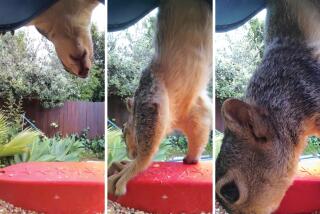GARDENING : Gopher Heavy Artillery to Get the ‘Schwarzenegger of Mice’
- Share via
“How ‘bout a nice cool drink, varmints? Scum, slime, menace to the golfing industry. You’re a disgrace and you’re varmints and you are one of the lowest of the food chain and you’ll probably be replaced by the rat.”
--Bill Murray, from the movie “Caddyshack”
Based on their roles in movies, one has to wonder whether gophers are really cute little balls of fur that must endure the persecution of the human race or nothing more than digging rats with a good public relations person.
It’s all a matter of perspective.
Hollywood casting agents have their idea, and those who watch their carefully manicured lawn turn into something resembling well-tilled farmland do too.
The gopher most people run into is actually a pocket gopher. It got its name because of the fur-lined pouches outside its cheeks, where it stores all the buds, roots, vegetables and grass it collects.
Gophers are usually loners that live underground in tunnels--except during mating season, when they practice their polygamist ways. They are members of the beaver, mice and squirrel family, which explains their mastery with digging and gathering. Gophers have very poor eyesight and rely on their tactile, hairless tail to help them feel their way.
While anyone with a small patch of grass can learn to hate gophers, it’s the golf course superintendent who is its sworn enemy.
Guy Auxer, the superintendent at Meadowlark Golf Course in Huntington Beach, once put a 50-cent bounty on gopher tails when he worked at a course in Long Beach.
“There would be a stack of tails on my desk, but we still weren’t getting anywhere,” Auxer said.
It’s a war that Auxer, 41, has been fighting for years.
The first time he had to deal with a gopher was in Colorado. “I was on a putting green, and the animal started digging outside the green. I patched it up and plugged the hole with soil. I didn’t know about baiting and trapping, and I wasn’t getting anywhere.
“I figured it out finally. I took a hose and turned the water on, he poked his head out of another hole, and I smashed him with the shovel right in front of the clubhouse.”
Today, Auxer’s methods of gopher control are a little more sophisticated. He is licensed to use aluminum phosphate, a gas used during World War I, along with other substances not available to the public.
He thinks that gopher eradication should be left to the professionals: “The bait could harm household pets or children if the bait is left on the surface. Keep in mind that gophers have strong forearms and shoulders and very sharp claws and teeth. You wouldn’t want to pick one up if it’s still alive, because gophers are the Arnold Schwarzenegger of mice.”
Gopher bait and traps can be found at neighborhood nurseries. A trap should cost about $5, bait goes for $7 a pound and gas pellets about $4 for four.
“Gophers have a keen sense of smell and will not touch anything that has a human scent to it,” Auxer said. “You will want to wear rubber gloves when setting a trap or working with bait.”
He also suggested finding the main tunnel and using a screwdriver to widen the opening. Drop the pellet or gas device into the hole to plug it up. The moisture in the ground will cause a toxic gas to be released.
Auxer also recommended a spring-loaded trap called a Macabee. Find the tunnel and set one trap on the right of the opening and another on the left. Wire the traps to a stake so the gopher will not run away with them.
By the next day, the pest should be in a trap--or at least outside the tunnel.
“What you have to do is fall back with superior firepower, superior intelligence and that’s all she wrote.
--Bill Murray in “Caddyshack”






